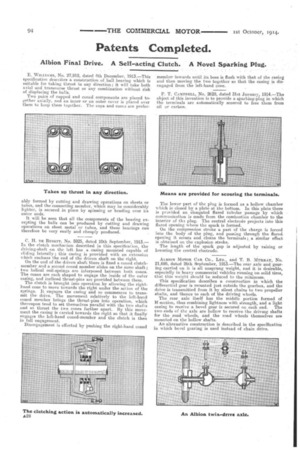Patents Completed.
Page 20

If you've noticed an error in this article please click here to report it so we can fix it.
Albion Final Drive. A Self-acting Clutch. A Novel Sparking Plug.
E. WILLiams, No. 27,918, dated 4th December, 1913.—This specification describes a construction of ball hearing which is suitable for taking thrust in any direction; it will take both axial and transverse thrust or any combination without risk of displacing the balls.
Two pairs of cupped and coned components are placed together axially, arid an inner or an outer cover is placed over them to keep them together. The cups and cones are prefer ably formed by cutting and drawing operations on sheets or tubes, and the connecting member, which may be considerably lighter, is secured in place by spinning or bending over its outer ends.
It will be seen that all the components of the bearing excepting the balls can be produced by cutting and drawing operations on sheet metal or tubes, and these bearings can therefore be very easily and cheaply produced.
C. H. DE RUSETT, No. 5925, dated 10th September, 1913.— rit the clutch mechanism described in this specification, the driving-shaft on the left ha ,s a .casing mounted capable of elidinr,6 laterally ; this casino. is provided with an extension which encloses the end of the driven shaft on the right.
• On the end of the driven shaft there is fixed a coned clutchinember and a second coned member slides on the same shaft; two helical coil-springs are interposed between both cones. The cones are each shaped to engage the inside of the outer casing, and inclined thrust-pins are provided between them. The clutch is brought into operation by allowing the righthand cone to move towards the right under the action of the springs. It engages the casing and so commences to transmit the drive. The movement, relatively to the left-hand coned member brings the thrust-pins into operation, which thereupon tend to set themselves parallel with the two shafts and so thrust the two cones further apart. By this movement the easing is carried towards the right so that it finally engages the left-hand coned-member and the clutch is then in full engagement. Disengagement is effected by pushing the right-hand coned
member inwards until it boss is flush with that of the casing and then moving the two together so that the casing is disengaged from the left-hand cone.
P. T. CAMPPELL, No. 2628, dated 31st January, 1914.—The object of this invention is to provide a sparking-plug in which the terminals are automatically scoured to free them from oil or carbon.
The lower part of the plug is formed as a hollow chamber which is closed by a plate at the bottom. In this plate there is provided an elongated flared tubular passage by which communication is ma-de from the combustion chamber to the interior of the plug. The central electrode projects into this flared opening where the spark is formed. On the compression stroke a part of the charge is forced into the body of the plug, and passing through the flared opening it scours and cleans the terminals;, a similar effect is obtained on the explosion stroke.
The length of the spark gap is adjusted by raising or lowering the central electrode.
ALBION MOTOR CAR CO., LTD., and T. B. MURRAY, No. 21,695, dated 26th September, 1913.—The rear axle and gearing carried on it is all unsprung weight, and it is desirable, especially in heavy commercial vehicles running on solid tires, that this weight should be reduced to the minimum.
This specification describes a construction in which the differential gear is mounted just outside the gearbox, and the drive is transmitted from it by silent chains to two propeller shafts, and thence to each of the driving wheels.
The rear, axle itself has the middle portion farmed of H section, thus combining lightness with strength, and a light casing to receive a bevel gear is secured on each end. The two ends of the axle are hollow to receive the driving shafts for the road wheels, and the road wheels themselves are mounted on the hollow shafts.
An alternative construction is described in the specification in which bevel gearing is used instead of chain drive.




















